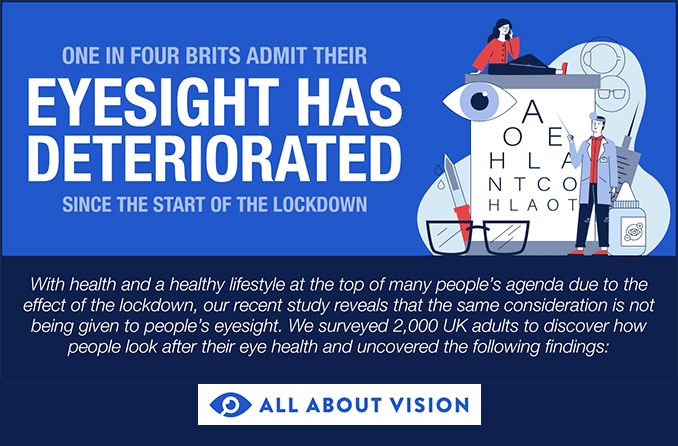Infographic: Eyesight deterioration and lockdown

The COVID-19 pandemic has been a difficult period for nearly too many reasons to count. While repeated UK lockdowns have lowered viral transmission, they haven't come without side effects.
Brits' eye health hasn't been spared from this list.
According to an All About Vision survey of more than 2,000 UK adults, we found that an alarming percentage believed their eyesight had deteriorated since the start of lockdown. Equally concerning was the number of people who wouldn't be able to recognize the symptoms of common eye problems.
Here's how Brits responded:
The first step to a solution is often recognizing a problem. With proper education about eye health symptoms — and how to reduce the visual impact of lockdown and more time spent indoors — you take an important step toward healthy vision that lasts a lifetime.
Leading optometrists Dr. Pamela Miller and Dr. Brian Chou, medical reviewers for All About Vision, explain the implications of leaving an eye condition untreated and provide top tips on how to spot them early:
1. Floaters
These can look like tiny spots, specks or flecks that drift aimlessly around in your vision. They aren’t a cause for concern and are very common. Normally, eye floaters are nothing to worry about. However, if they’re accompanied with flashes of light, it could indicate a retinal break. If left alone, it could visually impair the patient.
The best thing to do is to book an appointment with an optician as soon as you notice the floaters with the flashes of light.
2. Eye Fatigue
Symptoms for eye fatigue can vary, but the most common ones are dry eyes, watery eyes, headaches, light sensitivity and blurred or double vision.
Eye fatigue is generally caused by spending too much time on digital devices, so make sure to take regular breaks from laptops, tablets and phones throughout the day.
If the symptoms do persist, it’s best to get checked by your optician.
SEE RELATED: How to limit screen time during the coronavirus pandemic
3. Uveitis
Uveitis is inflammation of the middle layer of the eyeball, which consists of the iris, ciliary body and choroid. Collectively, these structures are called the uvea. Symptoms include light sensitivity, decreased eye acuity, eye pain and red eyes.
Uveitis unattended can lead to an increased risk of cataracts and glaucoma, and, in the worst case scenario, untreated uveitis could lead to permanent vision loss and worsening eye redness, pain and light sensitivity.
4. Tearing
Watery eyes, otherwise known as tearing, are usually temporary and can be treated with eye drops or by giving your eyes a break from digital devices. But constant watering could be a sign of an underlying condition.
The most common causes for watery eyes include allergies, digital eye strain, old or torn contact lenses, and debris (such as a loose eyelash). If left untreated, there is no major health implication, but it’s always best to get it checked out with your local optician.
TOP TIP: If your eyes are watering from allergies, eye strain or fatigue, you can press a cold spoon to your closed eyelids to relax your strained capillaries or use a warm compress to soften your meibum.
5. Blurry vision
Blurry vision is the loss of sharpness of eyesight, making objects appear out of focus and hazy.
If you’re starting to experience difficulty in reading things far away, increased headaches or words becoming blurry and difficult to read when you hold them close to your eyes, it’s best to get an eye test booked in with your optician, who will be able to help with your vision.
READ NEXT: Coronavirus linked to red or pink eye: How to protect your eyes
Page published on Monday, 30 August 2021







